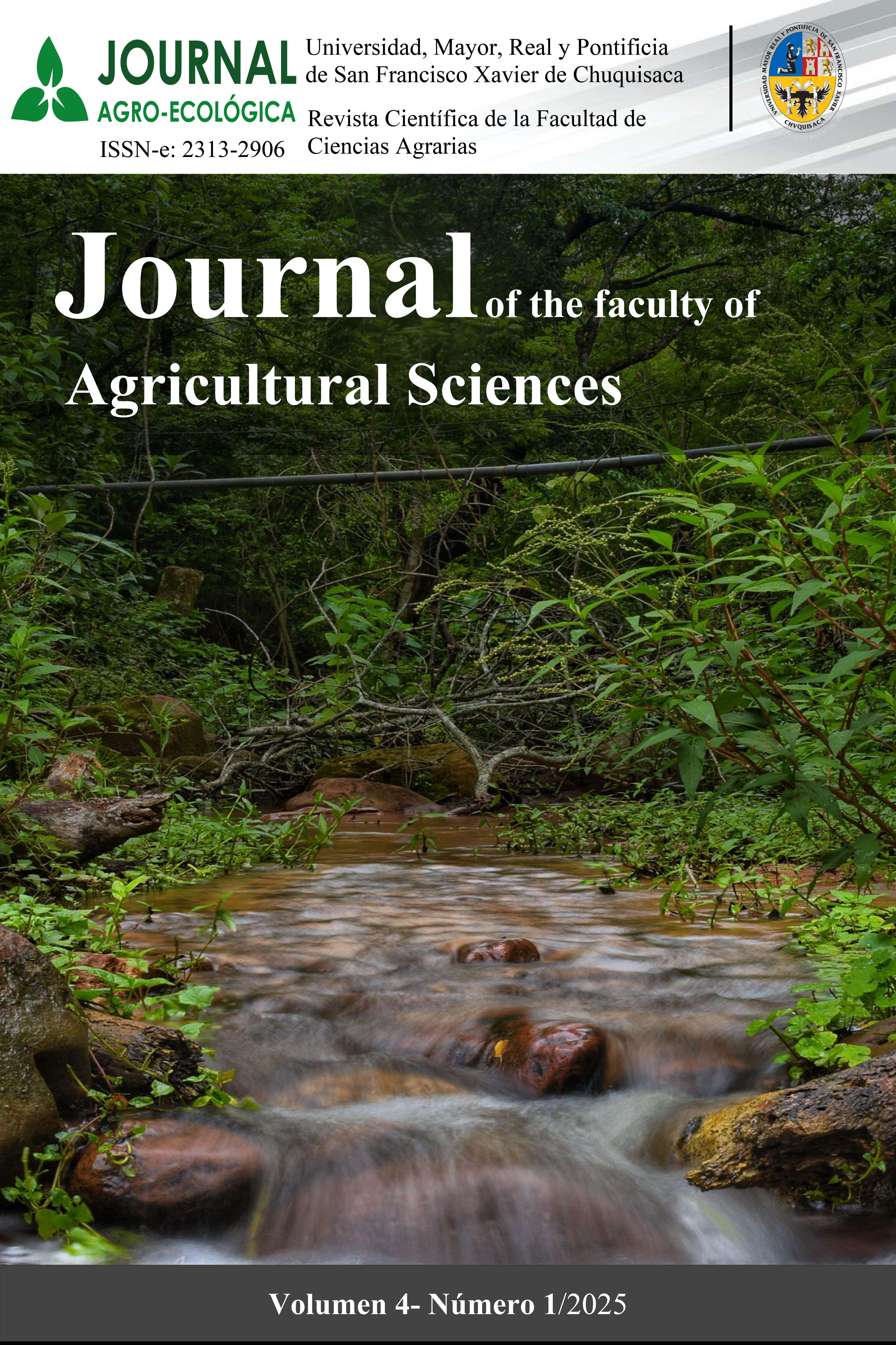Dinámica geomorfológicos del río El Bañado y su influencia en la formación de la laguna San Juan de Candua, Monteagudo (Chuquisaca, Bolivia)
Geomorphological dynamics of the El Bañado River and its influence on the formation of the San Juan de Candua lagoon, Monteagudo (Chuquisaca, Bolivia)
DOI:
https://doi.org/10.56469/rae.v4i1.1791Palabras clave:
dinámica morfológica fluvial, lago pequeño, palustreResumen
El estudio analiza los cambios geomorfológicos del sistema fluvial del río El Bañado y su relación con la formación y cambios de la laguna San Juan de Candúa, ubicado en el municipio de Monteagudo (Bolivia: Chuquisaca) durante los últimos 45 años. Para ello, se emplearon imágenes satelitales de alta resolución (KH-9 HEXAGON, SPOT y Airbus), cartas cartográficas 1:50 000 del Instituto Geográfico Militar y mediciones batimétricas in situ del lago. El análisis multitemporal revela que el río presentaba un curso sinuoso (1978), pero entre 1980 a 1987 comenzó un proceso de rectificación, probablemente debido a procesos naturales como erosión y sedimentación, así como por actividades antrópicas como la expansión urbana y obras viales. Estos cambios geomorfológicos habrían favorecido la formación de la laguna San Juan, visible desde 1991, producto de inundaciones recurrentes y alteraciones del cauce fluvial. Desde el 2002, se observan fluctuaciones significativas en el espejo de agua, alcanzando un máximo de 8 000 m² (2002), asociado a lluvias intensas y eventos de inundación, seguido de una disminución posiblemente vinculada a sequias, colmatación y presión antrópica. Sin embargo, muestra signos de eutrofización avanzada, similar a otras lagunas regionales afectadas por las actividades antropogénicas y el cambio climático. Estos resultados subrayan la importancia de monitorear la dinámica fluvial y lacustre para una adecuada gestión de los recursos hídricos, especialmente en contextos donde las actividades humanas interactúan fuertemente con sistemas naturales.
Citas
Ahmed, J. (2024). “Establishing the Hydrological Controls on Water Surface Area Variations in Oxbow Lakes”, Hydrological Processes, 38(12), https://doi.org/10.1002/hyp.70013
Allred, E.R., Manson, P.W., Schwartz, G.M., Golany, P. & Reinke, J.W. (1971). Continuation of Studies on the Hydrology of Ponds and Small Lakes, Minnesota, USA.
Bishop, M.P., James, L.A., Shroder, J.F. & Walsh, S.J. (2012). “Geospatial technologies and digital geomorphological mapping: Concepts, issues and research”, Geomorphology, 137(1): 5–26, https://doi.org/10.1016/j.geomorph.2011.06.027.
Boothroyd, R.J., Nones, M. & Guerrero, M. (2021). “Deriving Planform Morphology and Vegetation Coverage From Remote Sensing to Support River Management Applications”, Frontiers in Environmental Science, 9: 1–18, https://doi.org/10.3389/fenvs.2021.657354.
Boothroyd, R.J., Williams, R.D., Hoey, T.B., Barrett, B. & Prasojo, O.A. (2021). “Applications of Google Earth Engine in fluvial geomorphology for detecting river channel change”, Wiley Interdisciplinary Reviews: Water, 8(1): 1–27, https://doi.org/10.1002/wat2.1496.
Chaoyong, W., Aslam, R.W., Quddoos, A., Naz, I., Tariq, A., Ullah, S., Sajjad, A., et al. (2024). “SAR image integration for multi-temporal analysis of Lake Manchar Wetland dynamics using machine learning”, Scientific Reports, 14(1): 26669, https://doi.org/10.1038/s41598-024-76730-1.
Chen, T., Song, C., Zhan, P., Yao, J., Li, Y. & Zhu, J. (2022). “Remote sensing estimation of the flood storage capacity of basin-scale lakes and reservoirs at high spatial and temporal resolutions”, Science of the Total Environment, 807, https://doi.org/10.1016/j.scitotenv.2021.150772.
CNES, C.N. d’Études S. (2023). SPOT World Heritage Data Site, SPOT Images Acquired by CNES’s Spot World Heritage Programme, available at: https://regards.cnes.fr/user/swh/modules/60 (accessed 13 February 2025).
Constantine, J.A., Dunne, T., Ahmed, J., Legleiter, C. & Lazarus, E.D. (2014). “Sediment supply as a driver of river meandering and floodplain evolution in the Amazon Basin”, Nature Geoscience, 7(12): 899–903, https://doi.org/10.1038/ngeo2282.
Dewan, A., Corner, R., Saleem, A., Rahman, M.M., Haider, M.R., Rahman, M.M. & Sarker, M.H. (2017). “Assessing channel changes of the Ganges-Padma River system in Bangladesh using Landsat and hydrological data”, Geomorphology, 276: 257–279, https://doi.org/10.1016/j.geomorph.2016.10.017.
Doxaran, D., Castaing, P. & Lavender, S.J. (2006). “Monitoring the maximum turbidity zone and detecting fine‐scale turbidity features in the Gironde estuary using high spatial resolution satellite sensor (SPOT HRV, Landsat ETM+) data”, International Journal of Remote Sensing, 27 (11): 2303–2321, https://doi.org/10.1080/01431160500396865.
ESA, (European Space Agency). (2012), Sentinel-1: ESA’s Radar Observatory Mission for GMES Operational Services, edited by Fletcher, K., AG Noordwijk, The Netherlands.
Gautier, E., Brunstein, D., Vauchel, P., Roulet, M., Fuertes, O., Guyot, J.L., Darozzes, J., et al. (2006). “Temporal relations between meander deformation, water discharge and sediment fluxes in the floodplain of the Rio Beni (Bolivian Amazonia)”, Earth Surface Processes and Landforms, 32(2) 230–438, https://onlinelibrary.wiley.com/doi/10.1002/esp.1394
Gernez, P., Lafon, V., Lerouxel, A., Curti, C., Lubac, B., Cerisier, S. & Barillé, L. (2015). Toward sentinel-2 high resolution remote sensing of suspended particulate matter in very turbid waters: SPOT4 (take5) experiment in the Loire and Gironde estuaries, Remote Sensing, 7 (8) 9507–9528, https://doi.org/10.3390/rs70809507.
Google. (2018). Google Earth Pro, Google Maps/Google Earth, Santa Clara County, California, U.S.A.
Güneralp, I. & Rhoads, B.L. (2010). “Spatial autoregressive structure of meander evolution revisited”, Geomorphology, 120(3–4): 91–106, https://doi.org/10.1016/j.geomorph.2010.02.010.
Heino, J., Alahuhta, J., Bini, L.M., Cai, Y., Heiskanen, A.S., Hellsten, S., Kortelainen, P., et al. (2021). “Lakes in the era of global change: moving beyond single-lake thinking in maintaining biodiversity and ecosystem services”, Biological Reviews, 96 (1): 89–106, https://doi.org/10.1111/BRV.12647.
Hooke, J.M. (2007). Spatial variability, mechanisms and propagation of change in an active meandering river, Geomorphology, 84(3–4): 277–296, https://doi.org/10.1016/J.GEOMORPH.2006.06.005.
Hou, J., Van Dijk, A.I.J.M.V. & Beck, H.E. (2019). “A global, near real-time system measuring river, lake, and reservoir dynamics”, 23rd International Congress on Modelling and Simulation - Supporting Evidence-Based Decision Making: The Role of Modelling and Simulation, MODSIM 2019, No. December, pp. 712–718, https://doi.org/10.36334/modsim.2019.h5.houj.
IGM, (Instituto Geografico Militar). (2021). Bolivia Topographic Maps 1:50,000, Perry-Castañeda Library (PCL) Map Collection, available at: https://maps.lib.utexas.edu/maps/topo/bolivia/index-50k.html. (accessed 10 January 2025).
Jurgiel, B., Verchere, P., Tourigny, E. & Becerra, J. (2025). Profile Tool ver 4.3.2 [QGIS plugin]., QGIS Plugins Repository.
Kong, D., Latrubesse, E.M., Miao, C. & Zhou, R. (2020). “Morphological response of the Lower Yellow River to the operation of Xiaolangdi Dam, China”, Geomorphology, 350: 106931, https://doi.org/10.1016/J.GEOMORPH.2019.106931.
Latrubesse, E.M., Amsler, M.L., de Morais, R.P. & Aquino, S. (2009). “The geomorphologic response of a large pristine alluvial river to tremendous deforestation in the South American tropics: The case of the Araguaia River”, Geomorphology, 113(3–4): 239–252, https://doi.org/10.1016/j.geomorph.2009.03.014.
Li, Y., Zhang, Q., Cai, Y., Tan, Z., Wu, H., Liu, X. & Yao, J. (2019). “Hydrodynamic investigation of surface hydrological connectivity and its effects on the water quality of seasonal lakes: Insights from a complex floodplain setting (Poyang Lake, China)”, Science of The Total Environment, 660: 245–259, https://doi.org/10.1016/J.SCITOTENV.2019.01.015.
Ling, F., Li, X., Foody, G.M., Boyd, D., Ge, Y., Li, X. & Du, Y. (2020). “Monitoring surface water area variations of reservoirs using daily MODIS images by exploring sub-pixel information”, ISPRS Journal of Photogrammetry and Remote Sensing, 168: 141–152, https://doi.org/10.1016/J.ISPRSJPRS.2020.08.008.
Manson, P.W., Schwartz, G.M. & Allred, E.R. (1968), Some Aspects of the Hydrology of Ponds and Small Lakes, Minnesota, USA.
Mertes, L.A.K., Daniel, D.L., Melack, J.M., Nelson, B., Martinelli, A. & Forsberg, B.R. (1995). “Spatial patterns of hydrology, geomorphology, and vegetation on the floodplain of the Amazon River in Brazil from a remote sensing perspective”, Geomorphology, 13: 215–232, https://doi.org/10.1016/0169-555X(95)00038-7
Mertes, L.A.K., Dunne, T. & Martinelli, L.A. (1996). “Channel-floodplain geomorphology along the Solimões-Amazon River, Brazil”, Bulletin of the Geological Society of America, 108(9): 1089–1107, https://doi.org/10.1130/0016-7606(1996)108<1089:CFGATS>2.3.CO;2.
Moss, B. (2012). “Cogs in the endless machine: Lakes, climate change and nutrient cycles: A review”, Science of The Total Environment, 434:130–142, https://doi.org/10.1016/J.SCITOTENV.2011.07.069.
Neiff, J.J., Casco, S.L. & De Neiff, A.P. (2008). “Response of Eichhornia crassipes (Pontederiaceae) to water level fluctuations in two lakes with different connectivity in the Paraná River floodplain”, Revista de Biologia Tropical, 56(2): 613–623, https://doi.org/10.15517/rbt.v56i2.5612.
Paulino, R.S., Martins, V.S., Novo, E.M.L.M., Maciel, D.A., Correia-Lima, D.L., Barbosa, C.C.F., Bonnet, M.P., et al. (2023). “A framework based on spectral similarity to estimate hydrological connectivity in Juruá River floodplain lakes using 3-m PlanetScope data”, Journal of Hydrology, 625: 130156, https://doi.org/10.1016/j.jhydrol.2023.130156.
Puhakka, M., Kalliola, R., Rajasilta, M. & Salo, J. (1992). “River Types, Site Evolution and Successional Vegetation Patterns in Peruvian Amazonia”, Journal of Biogeography, JSTOR, 19(6): 651, https://doi.org/10.2307/2845707.
QGIS, D.T. (2020). QGIS Geographic Information System, Geospatial Foundation.
R Core Team, R. (2021). R: A language and environment for statistical computing, R Foundation for Statistical Computing, Vienna, Austria.
Rădoane, M., Perşoiu, I., Cristea, I. & Chiriloaei F. (2013). “River channel planform changes based on succesive cartographic data”. A methodological approach, Journal of Geomorphology, 15 69–88.
Salo, J., Kalliola, R., Häkkinen, I., Mäkinen, Y., Niemelä, P., Puhakka, M. & Coley, P.D. (1986). “River dynamics and the diversity of Amazon lowland forest”, Nature, 322(6076): 254–258. https://doi.org/10.1038/322254a0
Schallenberg, M., De Winton, M.D., Verburg, P., Kelly, D.J., Hamill, K.D. & Hamilton, D.P. (2013). “Ecosystem Services of Lakes, Ecosystem Services in New Zealand - Conditions and Trends”, pp. 203–225, https://doi.org/10.7931/DL1MS3
Schumm, S.A. (1963). “Sinuosity of Alluvial Rivers on the Great Plains”, Geological Society of America Bulletin, 74(9): 1089–1099, https://doi.org/10.1130/0016-7606(1963)74.
SENAMHI, (Servicio Nacional de Meteorología e Hidrología). (2023), “Observatorio nacional de servicio climático”, available at: https://senamhi.gob.bo/index.php/inicio (accessed 11 July 2025).
Shen, G., Fu, W., Guo, H. & Liao, J. (2022). “Water Body Mapping Using Long Time Series Sentinel-1 SAR Data in Poyang Lake”, Water, 14 (12): 1–26, https://doi.org/10.3390/w14121902.
Spada, D., Molinari, P., Bertoldi, W., Vitti, A. & Zolezzi, G. (2018). “Multi-temporal image analysis for fluvial morphological characterization with application to Albanian rivers”, ISPRS International Journal of Geo-Information, 7 (8), https://doi.org/10.3390/ijgi7080314.
Sun, T., Meakin, P., Jøssang, T. & Schwarz, K. (1996). “A simulation model for meandering rivers”, Water Resources Research, 32(9): 2937–2954, https://doi.org/10.1029/96WR00998.
Surian, N. & Rinaldi, M. (2003). “Morphological response to river engineering and management in alluvial channels in Italy”, Geomorphology, 50(4) 307–326, https://doi.org/10.1016/S0169-555X(02)00219-2.
Tandon, S.K. & Sinha, R. (2007). “Geology of large river systems”, in Gupta, A. (Ed.), Large Rivers: Geomorphology and Management, 7–41, https://doi.org/10.1002/9781119412632.ch2.
Torres-Batllo, J. (2020), Mapping Historical Hydrological Changes in the Lake Poop´ o Catchment, Bolivia, with Remote Sensing, University of Surrey - United Kingdom August.
USGS, (U.S. Geological Survey). (1995). CORONA Satellite Photography, NASA Open Data Portal, available at: https://data.nasa.gov/dataset/CORONA-Satellite-Photography/4rni-qjx7/about_data (accessed 22 January 2025).
Venegas-Cordero, N., Mediero, L. & Piniewski, M. (2024). “Urbanization vs. climate drivers: investigating changes in fluvial floods in Poland”, Stochastic Environmental Research and Risk Assessment, 38(7): 2841–2857, https://doi.org/10.1007/s00477-024-02717-z.
VRHyR, (Viceministerio de Recursos Hidricos y Riegos). (2010), “Delimitación y codificación de Unidades Hidrograficas de Bolivia: Metodología Pfafstetter”, MMyA-UICN-Comunidad Andina, La Paz, Bolivia.
Wang, Z., Xie, F., Ling, F. & Du, Y. (2022). “Monitoring Surface Water Inundation of Poyang Lake and Dongting Lake in China Using Sentinel-1 SAR Images”, Remote Sensing, 14(14) https://doi.org/10.3390/rs14143473.
Winter, T.C. (1999). “Relation of streams, lakes, and wetlands to groundwater flow systems”, Hydrogeology Journal, 7(1) 28–45, https://doi.org/10.1007/s100400050178.
Zambrano, A., Torres, J. and Ibarra, J. (2011), “Delimitación, codificación de las cuencas hidrográficas según los métodos de Pfasftetter”, Anais XV Simpósio Brasileiro de Sensoriamento Remoto -, SBSR-INPE, pp. 1105–1112.
ZONISIG. (2000), Zonificación Agroecológica y Socioeconómica del Departamento de Chuquisaca, La Paz - Bolivia.
Descargas
Publicado
Versiones
- 2025-08-22 (4)
- 2025-08-19 (3)
- 2025-07-31 (2)
- 2025-07-30 (1)





